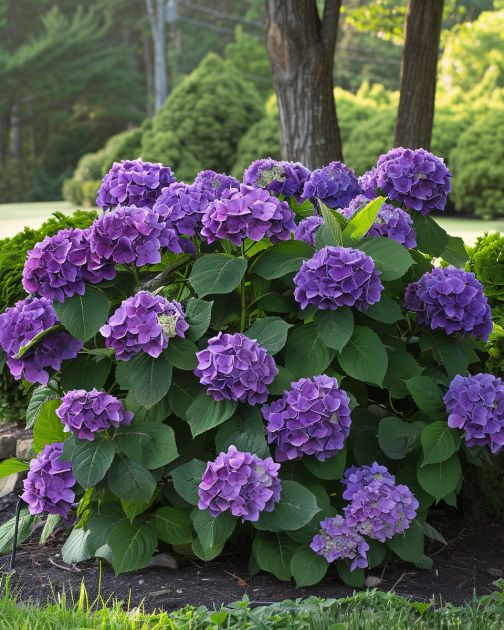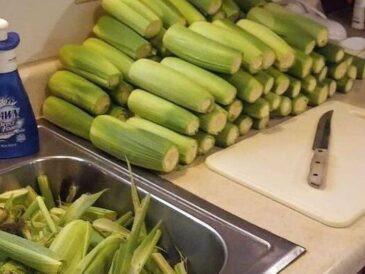Hydrangeas are relatively thirsty plants and require consistent moisture to thrive. However, they don’t like to sit in waterlogged soil. The key is to keep the soil consistently moist, but not soggy.
Here are some tips for watering your hydrangeas:
- Deep watering: Water deeply, ensuring that moisture reaches the root zone. Shallow watering can result in weak roots and poor growth.
- Mulching: Mulch around the base of the plant to help retain moisture and keep the roots cool. Organic mulches, such as wood chips or shredded bark, work well for hydrangeas.
- Watering schedule: During the growing season (spring and summer), water your hydrangeas 2-3 times a week. If there is a dry spell, increase watering to ensure the plant doesn’t dry out.
2. Pruning Hydrangeas
Pruning is one of the most important tasks when it comes to achieving fuller hydrangeas. Proper pruning can help your hydrangea grow stronger, produce more blooms, and maintain its shape.
The right time to prune depends on the variety of hydrangea you have:
- Bigleaf hydrangeas (Hydrangea macrophylla): These hydrangeas typically bloom on old wood (wood from the previous season). Prune them after they have finished blooming, typically in late summer or early fall. If you prune too early in the season, you risk cutting off the flower buds for the next year.
- Panicle hydrangeas (Hydrangea paniculata): These bloom on new wood, meaning they can be pruned in late winter or early spring before new growth begins.
- Smooth hydrangeas (Hydrangea arborescens): Like panicle hydrangeas, these bloom on new wood, so prune them in late winter or early spring.
- Oakleaf hydrangeas (Hydrangea quercifolia): Prune them after they have finished flowering in mid-to-late summer, as they bloom on old wood.
Tips for Pruning:
- Remove dead or damaged stems: Always cut away any broken, diseased, or dead wood to encourage healthy growth.
- Shape your plant: Trim back long, leggy stems to encourage branching and fuller growth. Aim to maintain a rounded shape, cutting the stems back by about one-third to one-half.
- Thin out crowded areas: If your hydrangea is getting crowded, remove some of the older stems from the base of the plant. This will allow light and air to reach the center of the shrub and promote more blooms.
3. Fertilizing for Healthy Growth
Fertilizing your hydrangeas is another key component of encouraging fuller blooms. Hydrangeas are heavy feeders, so providing them with the right nutrients is essential for their health and growth.
Here’s how to fertilize your hydrangeas:
- Use a balanced fertilizer: A slow-release, balanced fertilizer (such as a 10-10-10 formula) will provide a steady supply of nutrients to your hydrangeas. Apply fertilizer in early spring, just as new growth begins.
- Additional feeding: If your hydrangeas seem to be lacking nutrients or are showing signs of poor growth, apply a light dose of fertilizer every 6-8 weeks during the growing season.
- Organic matter: Incorporating compost or well-aged manure around the base of the plant can improve soil structure and add essential nutrients.
4. Ensuring the Right pH for Vibrant Blooms
The color of your hydrangea blooms can be influenced by the pH of the soil. Bigleaf hydrangeas, in particular, change color based on the acidity of the soil:
- Acidic soil (pH below 6) produces blue flowers.
- Alkaline soil (pH above 7) produces pink flowers.
To achieve the color you desire, you can adjust the pH of your soil:
- To make the soil more acidic (for blue blooms), add elements like sulfur or aluminum sulfate.
- To make the soil more alkaline (for pink blooms), you can add lime.
The Gardener’s Trick for Fuller Hydrangeas: The Secret is in the Cuttings
While all the aforementioned techniques will help your hydrangeas grow fuller, there is one advanced trick that many experienced gardeners swear by—taking cuttings and encouraging root growth in water or soil. This simple trick is an excellent way to ensure your hydrangeas stay healthy and bloom abundantly every year, and it also helps you expand your garden without having to buy new plants.
Step-by-Step Guide to Taking Hydrangea Cuttings:
- Choose a healthy hydrangea: Select a plant that is healthy and vigorous, with strong stems and plenty of blossoms.
- Cut a 4-6 inch stem
: Use sharp, clean pruners to cut a non-flowering stem that is mature but not too woody. 3. Remove the lower leaves: Strip off the leaves from the bottom half of the cutting to avoid rot. 4. Place the cutting in water: Submerge the cut end of the stem in water, ensuring the nodes (where leaves attach) are below the waterline. 5. Wait for roots to form: After about 3-4 weeks, the cutting should begin to form roots. Once the roots are at least 2 inches long, you can transfer the cutting to the soil.
By propagating your hydrangeas this way, you can grow new plants that will continue to produce fuller blooms year after year.
Conclusion: Nurturing Hydrangeas for Long-Lasting Blooms
Achieving fuller hydrangeas that bloom year after year requires dedication and knowledge of their care needs. By selecting the right spot for your hydrangeas, providing them with consistent water, appropriate sunlight, and proper fertilization, as well as following pruning and propagation techniques, you can enjoy an abundance of beautiful blooms every season.
The trick to ensuring your hydrangeas continue to thrive for years to come lies not just in the care you provide, but also in your ability to adapt to their unique needs. With these expert tips and tricks, you can create a garden that is filled with lush, vibrant hydrangeas that will provide elegance and charm for years to come. Happy gardening!




